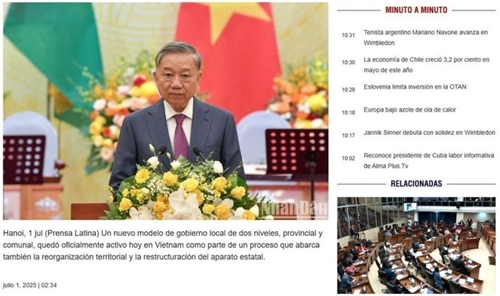Prensa Latina cited expert opinions as affirming that Vietnam is entering “a new era of state governance” with a modern, dynamic, and accessible administrative system. It said the reform reflects a fundamental shift from command-based administration to a substantive people-centered model, with authorities “daring to think, act, and take responsibility” in the face of requirements from digital transformation and global integration.
    |
 |
|
Prensa Latina highlights Vietnam's adoption of a two-tier local government model. |
The news agency highlighted General Secretary of the Communist Party of Vietnam (CPV) To Lam’s remarks, in which he stated that the reform transforms the principle of “a government that serves the people” from a slogan into reality. It quoted him as saying the reform is an essential response to the challenges of globalization, digital transformation, and the Fourth Industrial Revolution.
The change comes at a significant point in time for Vietnam, coinciding with the 95th anniversary of the CPV, the 80th founding anniversary of the nation, and 40 years of the Doi Moi (Renewal) process. The historic transition was marked symbolically with bells ringing simultaneously at 18,491 pagodas nationwide in a collective prayer for peace and prosperity, Prensa Latina wrote.
It lauded Vietnam’s bold decision to strongly empower commune-level governments – the administration level closest to citizens, and streamline the state apparatus, potentially saving trillions of VND in budget expenditure. The move was described as a clear affirmation of the principle that “power belongs to the people,” thereby enhancing the legitimacy of public institutions.
The scale of the reform is significant. Vietnam has cut the number of administrative units from 63 provinces and cities to 34, and the number of communes and wards from over 10,000 to just 3,321. Prensa Latina called it a “comprehensive administrative revolution” that enables the creation of large and better-resourced local units to drive sustainable development.
The Latin American media also commended the integration of this reform with Vietnam’s national digital transformation program. Despite some transitional challenges in decentralization, 34 provinces and cities have completed the establishment of online public service systems.
Prensa Latina expressed confidence that the two-tier local government model will serve as a key driver for Vietnam’s green economic development and enhanced governance capacity amid the Fourth Industrial Revolution and deep international integration.
Source: VNA